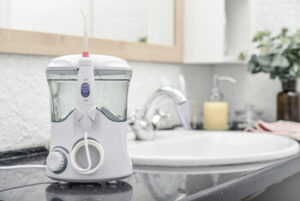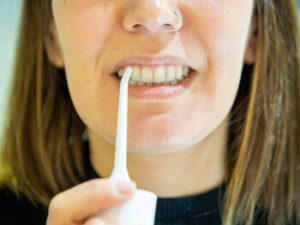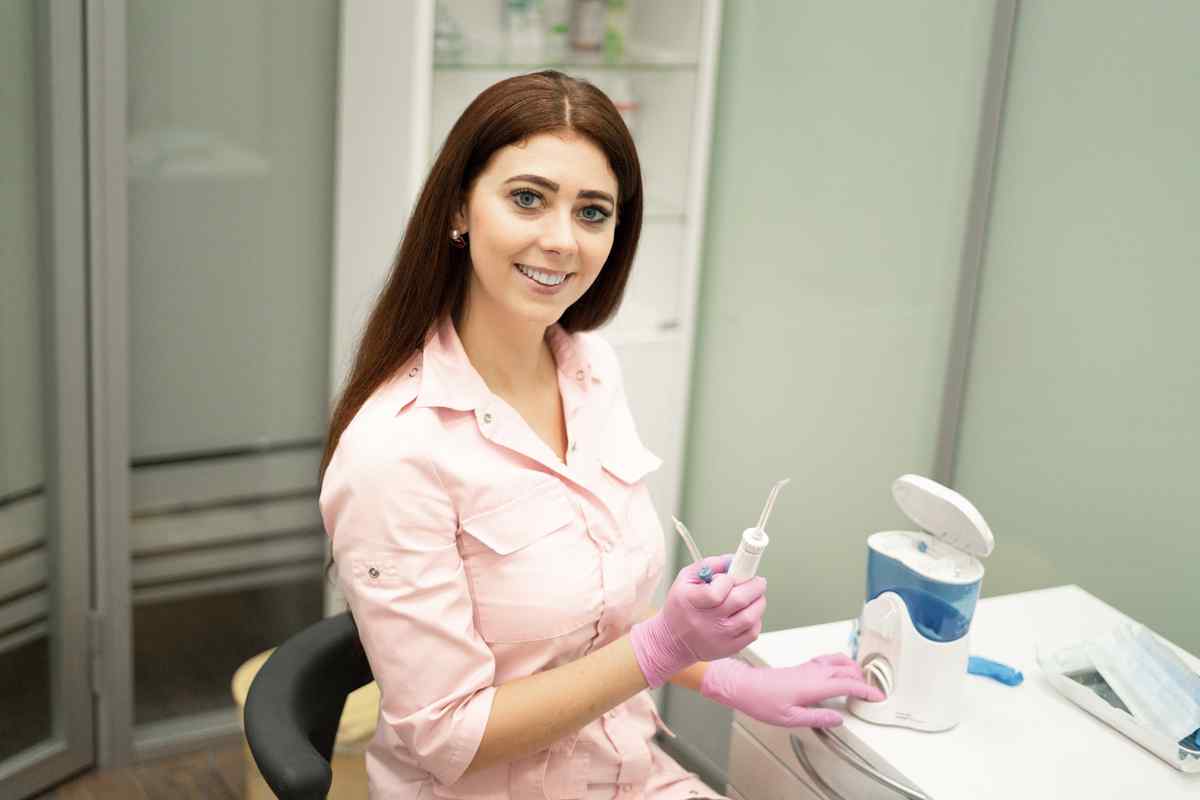Do you ever feel like your oral hygiene routine just isn’t working? Are your gums still pink and healthy, or are they becoming inflamed and receding? If so, then a water flosser might be the answer.
With just a few minutes of use each day, you can make huge strides in improving your mouth health and a much brighter smile too!
In this blog post, we explore the miracle of water flossers and what kind of results you can expect before and after using them. Learn more about how this must-have tool has transformed smiles everywhere!
The Basics of Water Flossing and Its Benefits
Water flossers are a device that aims a stream of water at your teeth. It’s also called an oral irrigator or dental water jet. Water flossing is an effective oral health tool, and it is becoming increasingly popular as an alternative to traditional dental floss.
 According to the American Dental Association, dental health can be significantly improved with the advanced technology of water flossers. Water flossers shoot a stream of pressurised water between teeth which removes food debris and plaque that is not only difficult to remove with dental floss but may not even be accessible.
According to the American Dental Association, dental health can be significantly improved with the advanced technology of water flossers. Water flossers shoot a stream of pressurised water between teeth which removes food debris and plaque that is not only difficult to remove with dental floss but may not even be accessible.
Additionally, these powerful devices help eliminate bacteria that traditional brushing alone cannot target, promoting oral hygiene in previously unavailable ways.
With regular use, water flossing can also help users reduce their risk of developing cavities, gingivitis and other oral health issues.
Types of Water Flossers and What They Can Do For You
Water flossers work well to help keep your oral hygiene in great shape. They have become a popular tool for many seeking a convenient solution to their dental care needs.
These devices use pressurised streams of water to clean debris from between teeth and along the gum line, effectively replacing standard dental floss. Common types of water flossers include countertop models and cordless battery-powered designs.
 Countertop models plug into a wall outlet for power and require a reservoir that must be continually filled with clean water. Cordless devices run on batteries and also feature refillable reservoirs that are easy to transport.
Countertop models plug into a wall outlet for power and require a reservoir that must be continually filled with clean water. Cordless devices run on batteries and also feature refillable reservoirs that are easy to transport.
Different types of attachments help make them versatile, so you can easily switch between brushing and flossing with just one device.
Ultimately, no matter what type you choose, water flossers can provide additional benefits at home as an orthodontic treatment when used alongside regular brushing and flossing habits recommended by dentists.
Before and After Water Flosser Results to Show How Water Flossers Can Help Improve Oral Hygiene
It’s amazing to look at before and after pictures that show the impact of a water flosser on oral hygiene. Even those who practise regular brushing and flossing may underestimate how much of an effect a water flosser can have on improving good oral health.
Because it is so effective in plaque removal and food debris, using a water flosser helps to reduce bacteria and ensures greater overall cleanliness of your teeth. Additionally, many people with braces or other dental issues find that adding a water flosser to their routine brings added comfort and convenience as they try to get around tight spaces or address hard-to-reach places.
And there are even studies that suggest that using a water flosser has been linked with an improved overall level of gum health for users.
If you want to improve your own dental care routine, giving a water flosser a try may be just the solution you need!
Understanding the Difference Between Traditional Brushing and Water Flossing
An effective oral hygiene routine is key to maintaining a healthy mouth, but many people are unaware of the differences between traditional brushing and water flossing.
Traditional brushing involves dry or wet brushing over the surfaces of the teeth and tongue with a toothbrush in long, even strokes, while water flossing involves shooting pressurised jets of specially formulated water around the teeth and gums to help remove plaque.
While both methods are important in maintaining a clean mouth, traditional brushing is more likely to be effective on hard-to-reach areas, such as in between teeth while water flossing can help flush out bacteria along the gum line. Overall, it is best to use both brushing and water flossing for maximum benefit and optimal oral health.
How to Use a Water Flosser Effectively
Water flossing is an effective way of cleaning the nooks and crannies in between your teeth and around braces or other tooth appliances. It can help to prevent gum disease and cavities, which is why it’s important to use a water flosser correctly.
 Start by filling the tank with cold or lukewarm water, setting the correct pressure level, and aiming the tip at a 45-degree angle toward the gum line. Move slowly back and forth while releasing short pulses of water to agitate plaque and food particles that may be stuck between your teeth.
Start by filling the tank with cold or lukewarm water, setting the correct pressure level, and aiming the tip at a 45-degree angle toward the gum line. Move slowly back and forth while releasing short pulses of water to agitate plaque and food particles that may be stuck between your teeth.
To cover all your bases, it’s best to move from one side of your mouth to another in an alternating pattern so you don’t miss any spots.
Finally, end off with a good rinse of warm water for extra sparkle. With consistent use, a good quality water flosser can work wonders for maintaining oral hygiene!
Top Tips to Maximise Results From Your Water Flosser
Regular water flossing is an essential part of any good oral hygiene routine. Water flossers are great for using between teeth, removing plaque and debris, and reducing bacteria levels in the mouth.
So, to get maximum results from your water flosser, use it twice a day at regular intervals, aiming to get water in between all teeth and behind each tooth.
 To make sure your dental health is in optimal condition, consider following the steps recommended by a dentist or dental hygienist – start with brushing the back of your lower teeth and then work up to the upper ones. This practice ensures that plaque buildup can be adequately eliminated, helping you stay away from tooth decay and periodontal disease!
To make sure your dental health is in optimal condition, consider following the steps recommended by a dentist or dental hygienist – start with brushing the back of your lower teeth and then work up to the upper ones. This practice ensures that plaque buildup can be adequately eliminated, helping you stay away from tooth decay and periodontal disease!
Manual brushing alone cannot provide such comprehensive coverage; however, this method guarantees to keep those pearly whites shining for years to come.
For best results, be sure to rinse your mouth with either a fluoride or non-fluoride solution following each water flosser session. This will not only keep your breath fresh but also safeguard against cavities, decay, and gum disease. Utilising these easy measures guarantees that you get the most out of every water flosser experience!
Conclusion
If you’re not a fan of traditional floss or string floss, then using a water flosser is an effective way to floss teeth and improve your oral hygiene and reduce the risk of cavities, gingivitis, and other dental issues.
With regular use, you can expect to see improved results with reduced plaque buildup in hard-to-reach areas as well as fresher breath overall. Ultimately, adding a water flosser to your routine may be just what you need for brighter smiles everywhere!
With these tips in mind, you’re well on your way to successfully using a water flosser. And if you need any additional advice or guidance along the way, don’t forget to contact Beyond Infinity Dental on (02) 8806 3799 – our experienced dentists are happy to answer all of your questions!
Sources
Is it more effective to floss teeth with a water flosser or with standard dental floss?
https://www.mayoclinic.org/healthy-lifestyle/adult-health/expert-answers/dental-floss/faq-20058112
Comparison between water flosser and regular floss in the efficacy of plaque removal in patients after single use
https://www.ncbi.nlm.nih.gov/pmc/articles/PMC8236551/
Evaluation of the plaque removal efficacy of a water flosser compared to string floss in adults after a single use
https://pubmed.ncbi.nlm.nih.gov/24282867/
Water flossers and Water flossing
https://www.mouthhealthy.org/all-topics-a-z/water-flossers










